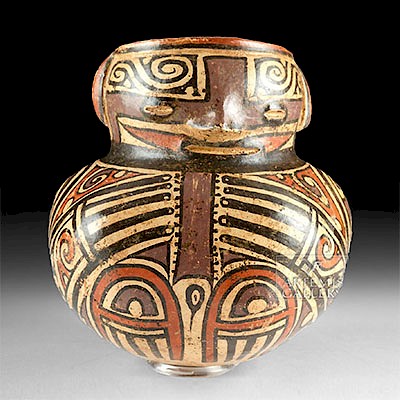18th C. Spanish Colonial Painting, St. Anthony & Christ
Lot 120
About Seller
Artemis Fine Arts
686 S Taylor Ave, Ste 106
Louisville, CO 80027
United States
Selling antiquities, ancient and ethnographic art online since 1993, Artemis Gallery specializes in Classical Antiquities (Egyptian, Greek, Roman, Near Eastern), Asian, Pre-Columbian, African / Tribal / Oceanographic art. Our extensive inventory includes pottery, stone, metal, wood, glass and textil...Read more
Estimate:
$1,000 - $1,500
Absentee vs Live bid
Two ways to bid:
- Leave a max absentee bid and the platform will bid on your behalf up to your maximum bid during the live auction.
- Bid live during the auction and your bids will be submitted real-time to the auctioneer.
Bid Increments
| Price | Bid Increment |
|---|---|
| $0 | $25 |
| $300 | $50 |
| $1,000 | $100 |
| $2,000 | $250 |
| $5,000 | $500 |
| $10,000 | $1,000 |
| $20,000 | $2,500 |
| $50,000 | $5,000 |
| $100,000 | $10,000 |
| $200,000 | $20,000 |
About Auction
By Artemis Fine Arts
Nov 8, 2018
Set Reminder
2018-11-08 10:00:00
2018-11-08 10:00:00
America/New_York
Bidsquare
Bidsquare : Ancient / Ethnographic From Around The World
https://www.bidsquare.com/auctions/artemis-gallery/ancient-ethnographic-from-around-the-world-3598
Ancient art from Egypt, Greece, Italy and the Near East, as well as Asian, Pre-Columbian, Native American, African / Tribal / Oceanic, Spanish Colonial, Russian Icons, Fine art, much more! Artemis Fine Arts info@artemisfinearts.com
Ancient art from Egypt, Greece, Italy and the Near East, as well as Asian, Pre-Columbian, Native American, African / Tribal / Oceanic, Spanish Colonial, Russian Icons, Fine art, much more! Artemis Fine Arts info@artemisfinearts.com
- Lot Description
Spanish Colonial, Mexico, ca. 18th century CE. A large oil on canvas depicting San Antonio de Padua (St. Anthony of Padua) holding the Christ Child. The tradition of this image stems from the story of Count Tiso of Padua, who witnessed St. Anthony communing with Jesus in child form while praying in his home. Here St. Anthony is shown wearing his friar robe of deep blue and gold and holding a frond of lilies in his right arm. In his left arm, he holds the Holy Child who is placing his hand on a globus cruciger (orb and cross). Both figures have haloes emanating from their heads. St. Anthony stands on a stone floor, yet clouds billow above the scene implying the celestial realm. Beside the pair is a table covered with a scarlet red cloth with a large gospel and an ink quill atop. On the opposite side is a billowing crimson curtain, a classic Baroque device. Size: 29.375" L x 22" W (74.6 cm x 55.9 cm)
The theme of this painting took root during the Counter-Reformation when religious art favored images of the Christ Child. The sweet moment between Saint Anthony and el Santo Nino became popular during the 16th and 17th centuries. Bartolome Esteban Murillo's famous "St. Anthony of Padua with the Child" (1665) for example resides in the Museum of Fine Arts of Seville. According to legend, St. Anthony was staying at Count Tiso of Padua's house, and his host noticed radiant light emanating from underneath the door of the saint's room. As the gentleman peered through the key hole, he was astonished to find that the source of the holy light was in fact the Christ Child seated in St. Anthony's arms.
Most of us assume that Franciscan habits are brown; however, the blue robe - as shown in this painting - was adopted by Spanish Franciscans and was characteristic for Franciscans during this period. It symbolized the monks' constant devotion to the immaculateness of the Virgin. It was not until a papal decree of 1897 that brown became the universal hue of Franciscan habits. The Christ Child's halo is also somewhat unusual - reduced to what is known as the tres potencias motif.
St. Anthony was a Portuguese Franciscan priest and friar who died in Padua, Italy. Despite being born into a wealthy family, he was known for his intense devotion to the poor and sick, and holds the distinction of being canonized most quickly of all the saints. He is also known as the patron saint of lost things - objects, people, and souls.
Provenance: private Hawaii, USA collection; ex-private El Paso, Texas collection, purportedly obtained in Mexico in the 1930's
All items legal to buy/sell under U.S. Statute covering cultural patrimony Code 2600, CHAPTER 14, and are guaranteed to be as described or your money back.
A Certificate of Authenticity will accompany all winning bids.
We ship worldwide and handle all shipping in-house for your convenience.
#138253Surface wear commensurate with age - showing losses to the canvas' peripheries and edges of stretcher bars, a small puncture to the canvas over St. Anthony's robes and another to the left of the quill on the table. The verso of the canvas has darkened with age.Condition
- Shipping Info
-
All shipping is handled in-house for your convenience. Your invoice from Artemis Gallery will include shipping calculation instructions. If in doubt, please inquire BEFORE bidding for estimated shipping costs for individual items.
-
- Buyer's Premium



 EUR
EUR CAD
CAD AUD
AUD GBP
GBP MXN
MXN HKD
HKD CNY
CNY MYR
MYR SEK
SEK SGD
SGD CHF
CHF THB
THB














